- Tom Philpott
- Posted On
News
- Lake County News reports
- Posted On
Nome Cult commemorations scheduled for Sept. 12-18
The walk will take place from Sunday, Sept. 12, through Saturday, Sept. 18.
Descendants of American Indians who took part in the original relocation and other supporters will walk from Chico to Covelo to commemorate the 147th anniversary of the trail, camping each night along the way.
Participants will descend into Round Valley the afternoon of Saturday, Sept. 18, to participate in a gathering sponsored by the Round Valley Indian Tribes at the Round Valley Reservation in Covelo.
The theme for the walk and gatherings is “Honor Their Memory … A Path Not Forgotten.”
The Mendocino National Forest asks that people traveling on forest roads along the trail route be aware of the event and careful of the walkers to ensure their safety.
This year, the walkers will begin at Bidwell River Road at 7 a.m. Sunday, Sept. 12. They will walk west on State Highway 32 and camp at the Buckhorn Campground at Black Butte Lake the first night. For the remainder of the week, they will walk across the Mendocino National Forest, following the Nome Cult Trail.
Their planned schedule is:
Monday, Sept. 13, Orland to Newville Cemetery, camp at Grindstone, Buckhorn Campground or Paskenta;
Tuesday, Sept. 14, Newville Cemetery to camp at Black Bear Campground;
Wednesday, Sept. 15, Black Bear Campground to camp at Log Springs;
Thursday, Sept. 16, Log Springs to camp at Wells Cabin;
Friday, Sept. 17, Wells Cabin to camp at Eel River Ranger Station;
Saturday, Sept. 18, walk into Round Valley.
The removal of Indians from Chico to the Round Valley Reservation in 1863 is one of the many forced relocations following the establishment of reservations in northern California in the 1850s.
At least eight different tribes were moved to the reservation after it was initially established as the Nome Cult Farm in 1856. It became a full-fledged reservation in 1958 and eventually was named Round Valley Reservation.
In September 1863, 461 Indians were marched under guard from Chico to the Round Valley Reservation nearly 100 miles across the Sacramento Valley and rugged North Coast Ranges.
Only 277 Indians completed the journey. Some were killed, a few escaped, and others were left behind, too sick to go on.
The route is now called the Nome Cult Trail.
The original path has largely disappeared as a result of road construction and maintenance. The most grueling part of the trail passed through what is now the Mendocino National Forest.
The Forest Service has placed interpretive signs along the route to mark places where the Indians and their military escorts camped.
A free brochure and trail map produced by the Forest Service is available from Mendocino National Forest offices for those interested in the route.
For further information on the event, please contact Sandra Knight, Chico Mechoopda Tribe at 530-899-8922, Extension 213, or Alberta Azbill, Round Valley Indian Tribes at 707-983-6126, Extension 11.
Follow Lake County News on Twitter at http://twitter.com/LakeCoNews and on Facebook at http://www.facebook.com/pages/Lake-County-News/143156775604?ref=mf .
- Elizabeth Larson
- Posted On
CHP releases new details on fatal Thursday hit and run
Manuel Herrera, 30, of Nice, was arrested in the case Thursday and charged with felony hit and run resulting in death and misdemeanor driving on a suspended license, according to jail records, which indicated Herrera posted $10,000 bail and was released.
The name of the 73-year-old man who Herrera is alleged to have hit Thursday morning has not yet been released pending notification of family, the CHP said Friday.
A report from CHP Officer Nick Powell explained that the crash victim, who was in a wheelchair, had left Robinson Rancheria Resort & Casino shortly before 2:30 a.m. Thursday. The man was traveling northbound along Highway 20's westbound shoulder.
At approximately 3:05 a.m., Herrera left his residence in Nice driving a 1992 Honda Civic, Powell's report noted.
Herrera was reportedly traveling westbound on Highway 20 at a high rate of speed because he was running late to work, Powell reported.
At 3:10 a.m. the elderly man had reached the intersection of Highway 20 and Upper Lake-Lucerne Road (east), with Powell reporting that Herrera was approaching the location at between 70 and 80 miles per hour.
For reasons which Powell said are still under investigation, Herrera allowed his vehicle to drift onto the highway's north shoulder, and the vehicle's right front section hit the man in the wheelchair.
The impact's force sent the man in the wheelchair airborne, with him coming to rest on his stomach in some grass just north of the highway's paved shoulder, parallel to the roadway. Powell said debris from the collision was strewn along the shoulder leading up to the location of the man's body.
Later in the morning Thursday a Caltrans crew observed the debris and during cleanup operations located the man's body, Powell said.
He said evidence at the scene led investigators to release information about the type of vehicle involved to the media.
Powell said that, based on an anonymous tip, law enforcement located Herrera later Thursday.
Alcohol is not suspected as a cause for the collision, Powell said.
E-mail Elizabeth Larson at This email address is being protected from spambots. You need JavaScript enabled to view it. . Follow Lake County News on Twitter at http://twitter.com/LakeCoNews and on Facebook at http://www.facebook.com/pages/Lake-County-News/143156775604?ref=mf .
- Lake County News Reports
- Posted On
Old Time Bluegrass Festival returns with toe-tapping music and fun
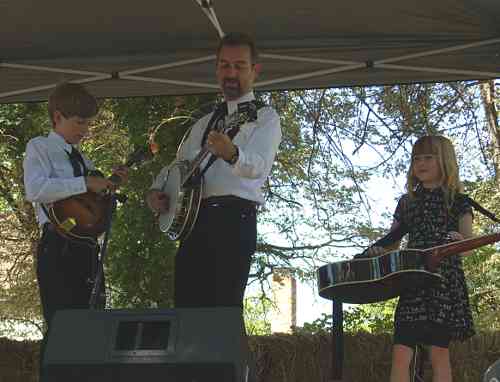
Anderson Marsh State Historic Park is well-known to Lake County residents as a preserved slice of the American West, with the property donated by the Anderson family, several of whom were in attendance on Saturday.
The park is now home to the annual Old Time Bluegrass Festival, now in its fifth year.
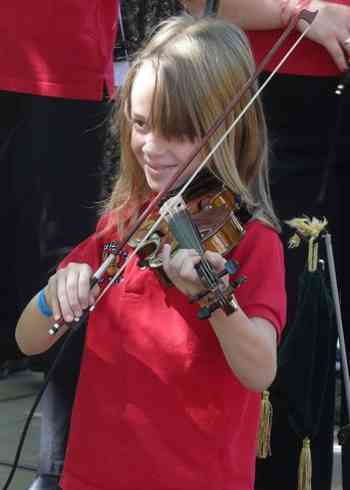
Several local favorites – including the Cobb Stompers, Clear Lake Clikkers and the Konocti Fiddle Club – kicked off the event, which was simulcast on KPFZ 88.1 FM, Lake County Community Radio.
“It's such a pleasure to work with everyone to put this magnificent event on,” said Gae Henry, a member of the steering committee and a driving force behind the event.
Henry spoke passionately to the event-goers about supporting Proposition 21, a state initiative which would create a designated funding source for California State Parks separate from general fund allocations.
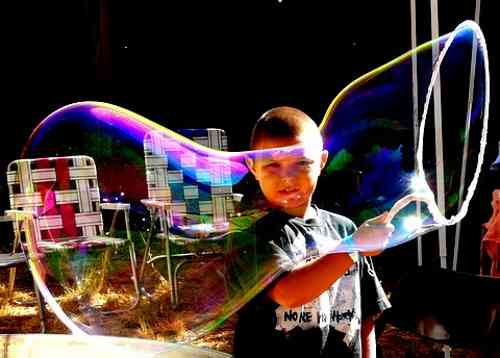
There also was a special presentation to the Lake County Volunteer Firefighters to thank local first responders on the ninth anniversary of Sept. 11, 2001.
“As always,” Henry said, “we've been given tremendous support form the Clear Lake Chamber of Commerce, as well as the Children's museum of Art and Science to put on this event.”
She said they also received help from Carlé Continuation High School and Lower Lake High School.
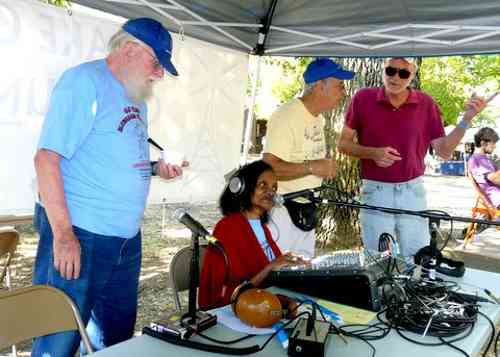
- Lake County News reports
- Posted On
REGIONAL: Country's oldest grange, oldest granger celebrated
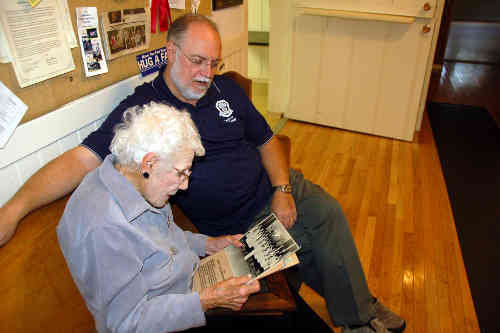
She smiled and proudly claimed her 85 years as a member of this oldest continuously operating Grange in the nation, founded May 27, 1873.
And it just so happens that at her splendid age of 105, Burow is the oldest Grange member in the nation.
“We have history here,” she said simply.
Ann Burow was born in Oakland, Calif., on Oct. 23, 1905. To say she came from a large family is an understatement. She had 14 brothers and sisters.
She described herself as a “city girl who came to the country.” A friend introduced her to a dairyman named George. They were married in 1924 and she moved to live with George and 70 cows on his farm in the Bennett Valley.
“I didn’t know anything about farm life,” she confessed. “But I went out there on an unpaved country road.”
She paused, recalling fondly a time long ago. “It was like a storybook unfolded. A little farm house with no electricity and a hardwood stove.”
The farm was run by George and his brother. “The two men took care of the farm. I used to watch them. It was an education in itself. None of the milk ever touched anything piped. They carried the milk in big cans.”
On the farm, they raised two daughters, Luella and Gwen. “The oldest girl was her father’s girl,” she said. “She would drive the tractor with him and ride it through the fields to school.”
On Valentine’s Day 1925, Ann joined the Bennett Valley Grange. Within a year, the members elected her as the secretary and she served in that position for 65 years before retiring in December 1990.
The Grange is a grass roots organization that began in 1867, in the aftermath of the destructive and divisive Civil War.
Rising from the fields and farmlands, survivors gathered on common ground to heal and support each other, work together, and honor traditional values.
The Grange grew rapidly, building halls across the rural landscape of America.
Cities and townships have grown up around rural halls and the Grange has evolved into a community service organization with 10,000 members and 206 chapters across California. Grange halls are often the center of their community, providing opportunities, culture and education, entertainment, emergency shelter, and a meeting place where new friends are made and old friends are cherished.
Everyone is welcome to apply for membership in the Grange. Each member contributes at their own pace and level of participation. Each Grange decides how to best serve the community.
Member Donald Turpley recorded an excellent history of the Bennett Valley Grange and it is available in its entirety on the California Sate Grange Web site at www.californiagrange.org/news/pdf/bennettvalley.pdf.
Quoting from Turpley’s research, “On April 26, 1873, 16 residents of the valley met informally at the old Strawberry School to discuss the possibility of organizing a Grange.”
A month later, 25 founding members met at the home of George Whitaker to formally organize the Grange. Men paid $3 each for dues and women paid 50 cents each. Elmira Whitaker prepared a bountiful harvest feast from food grown on her ranch.
Praising the organization of the new Grange in a letter to the Sonoma Democrat, George Whitaker wrote, “Bennett Valley Grange has taken the lead in Sonoma County in the good cause and may the work go on until every tiller of the soil will sing to the tune of we are coming, some 80,000 strong, to save our sons and daughters from the clutches of the monopolies and rings.”
In the months that followed, Granges quickly formed in the surrounding communities of Santa Rosa, Petaluma, Two Rock, Bloomfield, Bodega, Green Valley and Glen Ellen. During the month of April 1873, 571 new Granges were formed across the country, bringing the total to over 4,000 nationwide. The National Grange was not even six years old.
The new members of the Bennett Valley Grange wasted little time building a hall. The new hall was dedicated on Dec. 4, 1873, a date selected to coincide with the sixth anniversary of the founding of the National Grange. The lumber used to build the hall was brought by wagon from Occidental and cost $292.82.
Fast forward. On a lovely summer day, June 6, 2010, folks from all corners of Sonoma County and beyond gathered to celebrate the 138th consecutive annual picnic and barbecue at the Bennett Valley Grange.
For more than a century, the community comes together on this day to celebrate this grand old hall and the good work of the Grange.
Much like the bountiful feast served at the founders’ meeting, the food was plentiful and good. Guests were served half of a big barbecued chicken (these birds looked more like pterodactyls), delicious fresh salads and two desserts.
Picnic tables were set up outside the hall to accommodate the hundreds of people that showed up. There was a live band and dancing. Inside the hall, dozens of wonderful gift baskets and other prizes were set on tables for a silent auction. The local 4-H had rabbits, pigs, goats and chickens on display.
"For the first time we partnered with another nonprofit organization,” explained Bennett Valley Grange Secretary Bill Allen. “We decided to split the cost, profits and work with the emergency preparedness committee of the Bennett Valley Homeowners Association. This partnership proved successful by increasing attendance and increasing the participation of the community in preparation for the event. "
In 1925, when Ann Burow joined the Grange, there was no electricity. The main hall had a big heater and was lit by three huge oil lamps down the center. Most folks arrived in horse drawn buggies.
“We had an old Dodge with no glass windows,” she said. “You had to put the curtains up when it rained.”
“It was nothin’ to have 30 to 40 people here at a meeting,” Burow said. “The ritual was most important. We had two beautiful ritual teams. I was the drill master. We wore evening gowns. That is how we dressed – not in bikinis!
She added, “I was so proud of that team. We went all over the county. In those days lots of people joined the Grange. At one time we had 300 members. We were a friendly group. Everything centered here. We had lively programs and our lecturer was very good.”
Burow knew George and Elizabeth Shelmeyer. For decades, George served as California’s most venerable State Master.
“I knew Elizabeth when she was a little girl,” Burow recalled. “She became a school teacher and married George when he became the Master. They lived in Bennett Valley on Grange Road. They lived a very happy life. They were a nice couple.
“Today, the kids have so much more than we had. They can get anything. They just Google it,” she said, amused.
Her advice to young people is that they stay in school and get a good education.
Burow's favorite memory of the Bennett Valley Grange was the 100th anniversary in 1972, a weeklong gala celebration culminating in a formal dance at the hall.
“It’s a picture in my mind that never leaves,” she said. “Nowadays, people are casual. This world has changed. The whole world has never been the same since the war and it will never be the same again.”
At the June picnic, Burow beamed. “To sit up here and see the crowd … it’s wonderful.”
"Sister Ann Burow is an amazing person who just happens to be 105 years old,” said Bennett Valley Grange Master Patty Allen. “She remembers and has taught us many things about Bennett Valley Grange. She is very accepting and appreciative of new members and new ideas while always happy to share memories of the past if asked. I'm proud to call her a friend.”
“What I’ve told you is true. We love this old hall,” said Burow. “The very first time I came here I said, Oh, I love this place. And as years rolled by the love is still there, really.”
Ann Burow and the Bennett Valley Grange “have history here.” They are inseparable. Together, they represent the very best that is the Grange.
For more information on Granges in California, phone the State Grange office at 916-454-5805 or visit www.californiagrange.org.
Follow Lake County News on Twitter at http://twitter.com/LakeCoNews and on Facebook at http://www.facebook.com/pages/Lake-County-News/143156775604?ref=mf .
- Elizabeth Larson
- Posted On
Live wire closes down road in Kelseyville
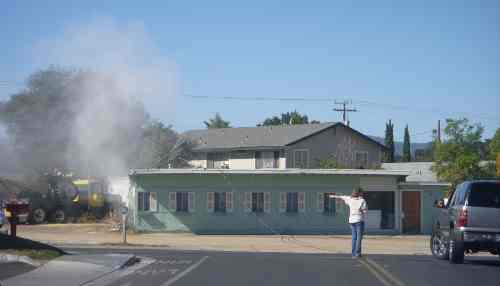
KELSEYVILLE, Calif. – Safety concerns due to a fallen wire caused a road closure on Friday morning in Kelseyville.
The wire fell down across Main Street in Kelseyville at the intersection with State Street shortly before 11 a.m.
At the same time, smoke was billowing from a nearby building, with a man using a fire extinguisher around the back of the structure.
Several community members stood in the street to warn drivers to detour around the area, as the wires were reported to be live.
Kelseyville Fire Protection District and Pacific Gas & Electric responded to the scene.
PG&E did not have additional details about the incident late Friday.
E-mail Elizabeth Larson at This email address is being protected from spambots. You need JavaScript enabled to view it. . Follow Lake County News on Twitter at http://twitter.com/LakeCoNews and on Facebook at http://www.facebook.com/pages/Lake-County-News/143156775604?ref=mf .
- Lake County News Reports
- Posted On
The Veggie Girl: Magnificent melons

- Lake County News reports
- Posted On
Pictures of the day: Egret and heron visit Beryl Bay
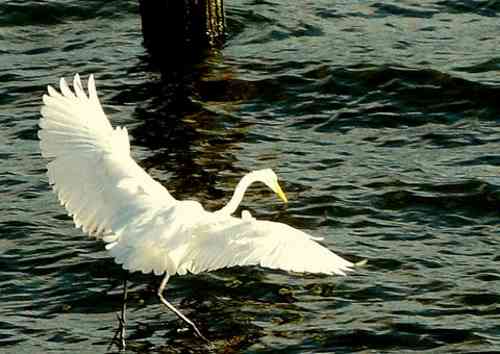
CLEARLAKE OAKS – Cool weather and improving lake conditions drew some visitors to Clearlake Oaks this week.
Miguel Lanigan captured an egret and a blue heron in Beryl Bay on Friday.
The cool weather sank the algae in the area, he said, with the feathered visitors showing up afterward.
Follow Lake County News on Twitter at http://twitter.com/LakeCoNews and on Facebook at http://www.facebook.com/pages/Lake-County-News/143156775604?ref=mf .
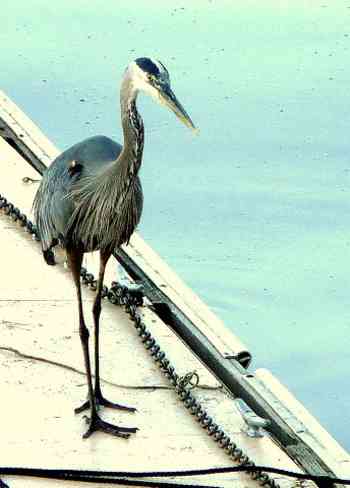
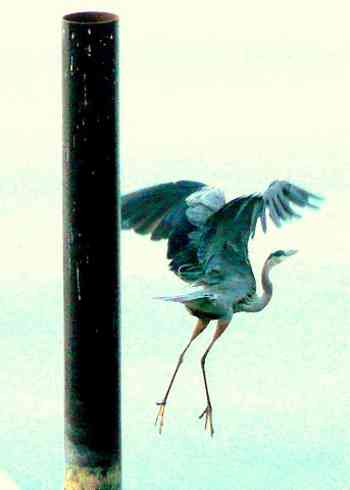
- Lake County News reports
- Posted On
Officials: Swimmer's death resulted from heart attack, not drowning
CLEARLAKE PARK – A man who initially was believed to have drowned in an incident last weekend appears instead to have died of a heart attack.
Roger Alvin Machado, 73, was pronounced dead at St. Helena Hospital Clearlake Sunday night after doctors were unable to revive him, according to a report from Capt. James Bauman of the Lake County Sheriff's Office.
Bauman said sheriff's deputies were dispatched to the scene at around 7:40 p.m. Sunday on the report of a possible drowning.
When deputies arrived, rescue personnel from Lake County Fire and Clearlake Police were already on scene, performing life saving protocols on Machado, Bauman said.
Lake County Fire continued their efforts to save Machado while transporting him to the Saint Helena Clearlake Hospital, Bauman said. However, despite having “very faint” signs of life on arrival there, emergency room staff were unable to resuscitate him and he was pronounced deceased.
Machado’s friend of 10 years, Joanne Simpson, and her daughter, Kathy Shrever, told deputies Machado and Shrever had gone down to the lake for a swim with Machado’s dog after having dinner, Bauman said.
Shrever said she watched Machado dive into the lake but he never surfaced, according to Bauman's report. After several minutes, Shrever saw Machado’s water shoes surface so she began screaming for help.
Bauman said several unidentified neighbors reportedly responded to the water and were eventually able to find Machado and pull him to shore.
An autopsy was performed on Machado Thursday morning at the Jones and Lewis Mortuary in Lower Lake and a preliminary cause of death indicates that he did not actually drown, but rather died of heart failure, according to Bauman. A final cause of death is pending the results of a toxicology screening.
Sheriff Rod Mitchell and his staff extended their condolences to Machado's loved ones and commended the citizens who acted swiftly and bravely in trying to save Machado’s life.
Follow Lake County News on Twitter at http://twitter.com/LakeCoNews and on Facebook at http://www.facebook.com/pages/Lake-County-News/143156775604?ref=mf .
- Dr. Tony Phillips
- Posted On
Space News: Fireballs light up Jupiter
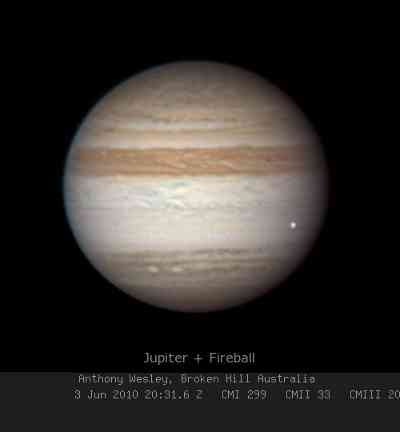
In a paper published Thursday in the Astrophysical Journal Letters, a group of professional and amateur astronomers announced that Jupiter is getting hit surprisingly often by small asteroids, lighting up the giant planet's atmosphere with frequent fireballs.
"Jupiter is a big gravitational vacuum cleaner," said co-author and JPL astronomer Glenn Orton. "It is clear now that relatively small objects left over from the formation of the solar system 4.5 billion years ago still hit Jupiter frequently."
The impacts are bright enough to see through backyard telescopes on Earth. Indeed, amateur astronomers were the first to detect them, recording two fireballs in 2010 alone – one on June 3 and another on Aug. 20.
Professional astronomers at NASA and elsewhere have followed up on the amateur observations, hoping to learn more about the impacting bodies.
According to Thursday's Letter, first-authored by Ricardo Hueso of the Universidad del País Vasco in Spain, the June 3 fireball was caused by an object some 10 meters in diameter. When it hit Jupiter, the impact released about one thousand million million (10^15) Joules of energy.
For comparison, that's five to 10 times less energy than the "Tunguska event" of 1908, when a meteoroid exploded in Earth's atmosphere and leveled millions of trees in a remote area of Russia. Scientists continue to analyze the Aug. 20 fireball, but think it was comparable in scale to the June 3 event.
Before amateurs spotted these fireballs, scientists were unaware collisions so small could be observed.
The first hint of their easy visibility came in July 2009 when Anthony Wesley, an amateur astronomer from Australia, discovered a dark spot on Jupiter. It was clearly the swirling debris of an impact event that he had only just missed.
Next time, however, his luck would improve. On June 3, 2010, he caught a fireball in action.
"I was watching real-time video from my telescope when I saw a 2.5-second-long flash of light near the edge of Jupiter's disk," said Wesley. "It was clear to me straight away it had to be an event on Jupiter."
Another amateur astronomer, Christopher Go of the Philippines, confirmed that the flash also appeared in his recordings.
Professional astronomers, alerted by email, looked for signs of the impact in images from larger telescopes, including NASA's Hubble Space Telescope, the European Southern Observatory's Very Large Telescope in Chile, and Gemini Observatory telescopes in Hawaii and Chile.
Scientists saw no thermal disruptions or typical chemical signatures of debris, which allowed them to put a limit on the size of the object.
The second fireball on Aug. 20 was first detected by Japanese amateur astronomer Masayuki Tachikawa of Kumamoto city and quickly confirmed by another Japanese amateur, Aoki Kazuo of Tokyo. This one flashed for about 1.5 seconds and, like the June 3rd fireball, left no debris observable by large telescopes.
"It is interesting to note that while Earth gets smacked by a 10-meter-sized object about every 10 years on average, it looks as though Jupiter gets hit with the same-sized object [as much as] a few times each month," said Don Yeomans, manager of the Near-Earth Object Program Office at JPL, who was not directly involved in the study.
Learning how often Jupiter is hit can tell astronomers something about the meteoroid population throughout the solar system – a matter of considerable interest right here on Earth.
Just this past week, on Sept. 8, a 10-meter class asteroid named 2010 RF12 flew past our planet without hitting. A somewhat smaller space rock, 2008 TC3, actually burned up in the atmosphere above Sudan two years ago.
"The Jupiter impact rate is still being refined," added Yeomans, "and studies like this one help to do just that."
To learn more about the original research, read "First Earth-based Detection of a Superbolide on Jupiter" by R. Hueso et al, in the Ap J Letters, 2010, 721, L129.
For additional information and videos, visit http://science.nasa.gov/science-news/science-at-nasa/2010/09sep_jovianfireballs/.
Follow Lake County News on Twitter at http://twitter.com/LakeCoNews and on Facebook at http://www.facebook.com/pages/Lake-County-News/143156775604?ref=mf .

- Elizabeth Larson
- Posted On
Major injury collision reported near Napa County line
The California Highway Patrol reported that the two-vehicle crash occurred on Highway 29 near the Napa County line just after 7:30 p.m.
One vehicle was off the side of the road, with traffic backing up, the CHP said. Animal Care and Control was summoned to help with a domestic pig.
The CHP requested one of its Santa Rosa units respond to Santa Rosa Memorial Hospital to pick up a blood sample.
The roadway was reopened just before 9:30 p.m., the CHP said.
Additional details, including the names of those involved, was not available Friday night.
E-mail Elizabeth Larson at This email address is being protected from spambots. You need JavaScript enabled to view it. . Follow Lake County News on Twitter at http://twitter.com/LakeCoNews and on Facebook at http://www.facebook.com/pages/Lake-County-News/143156775604?ref=mf .
- Lake County News reports
- Posted On
Kelseyville Unified plans next district configuration meeting
KELSEYVILLE, Calif. – The Kelseyville Unified School District Board of Trustees will host its next special meeting to discuss district configuration plans for the 2011-12 school year on Tuesday, Sept. 14.
The meeting will begin at 7 p.m. in the Kelseyville High School Student Center, 5480 Main St.
District officials said they're faced with declining enrollments that are expected to continue until 2013-14, coupled with a continuing drop in revenue.
In order to assess how to best use the district's resources and its eight school sites, they're holding a series of community meetings to gather public input and begin the process of putting together proposals for the board to make a final decision in November.
The first meeting was held Aug. 10, as Lake County News reported.
Other special board meetings planned on configuration are set for Oct. 5 and Nov. 9, also at the high school student center.
For more information, call the Kelseyville Unified School District Office at 707-279-1511 or email This email address is being protected from spambots. You need JavaScript enabled to view it..
Follow Lake County News on Twitter at http://twitter.com/LakeCoNews and on Facebook at http://www.facebook.com/pages/Lake-County-News/143156775604?ref=mf .
LCNews
Responsible local journalism on the shores of Clear Lake.
Memberships:
 |
 |
 |
 |
 |
 |

